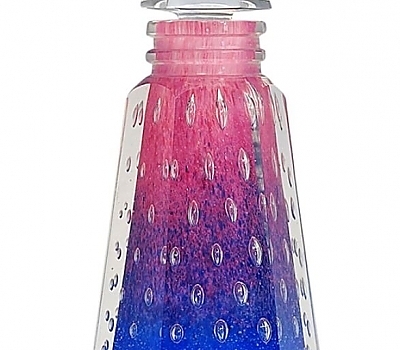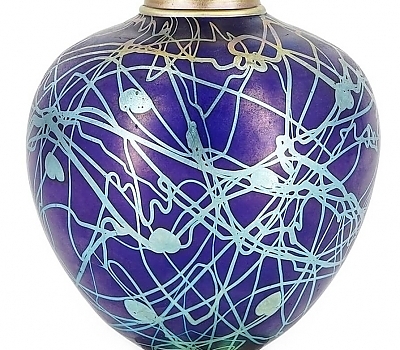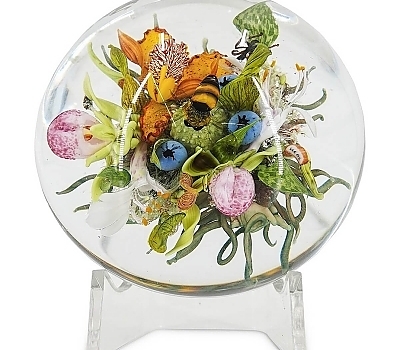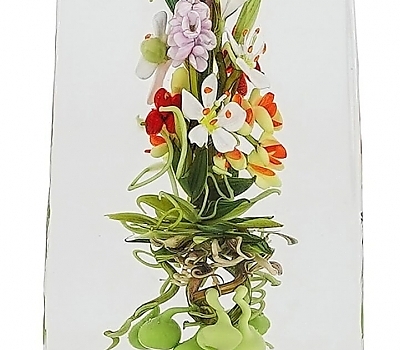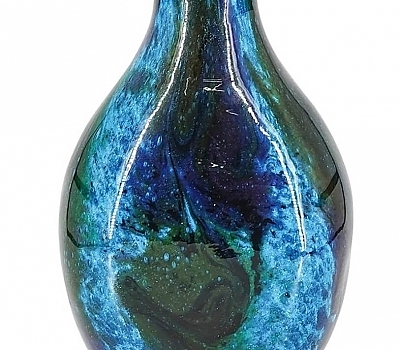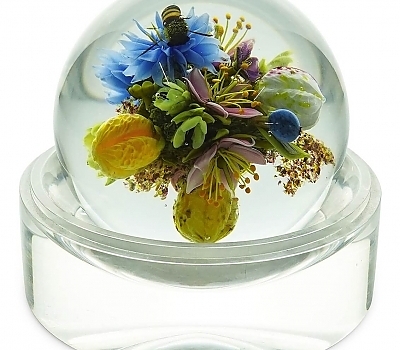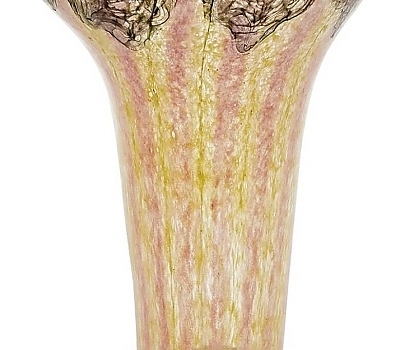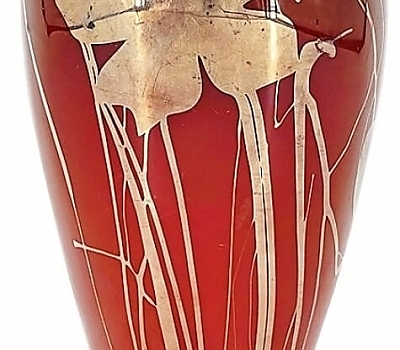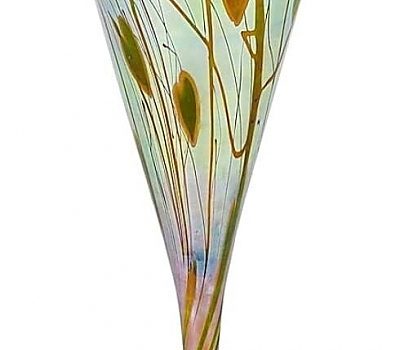By using our website, you agree to the use of cookies as described in our Cookie Policy
Rare Steuben Glass Pieces Sell At Akiba Antiques
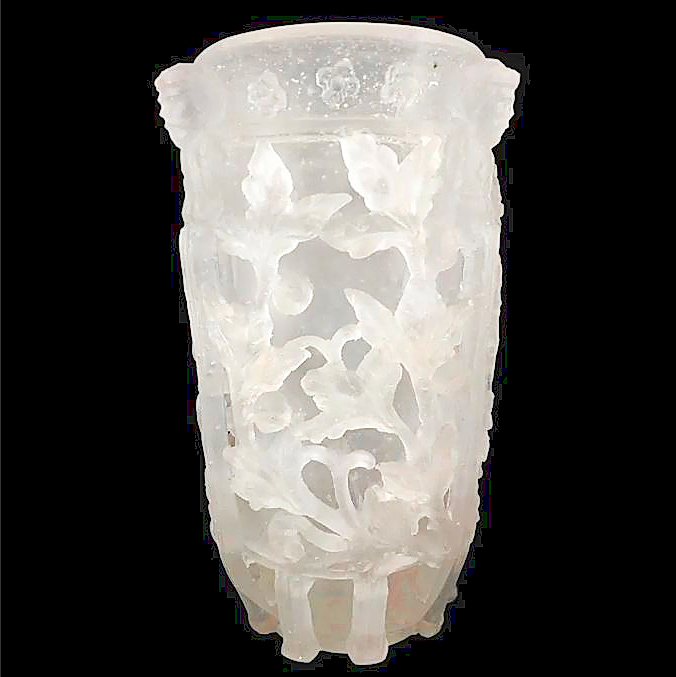
Leading the sale was this rare Steuben Diatreta vase. It surpassed its $25,000 high estimate to bring $46,875. Art Nouveau master glassmaker Frederick Carder created the piece in 1953 and used the term Diatreta to describe openwork objects made with the lost wax technique. The frosted glass vase featured elaborate floral details in high relief.
Review by W.A. Demers, Photos Courtesy Akiba Antiques
DANIA BEACH, FLA. – Following the successful sale of one of the world’s largest and rarest collections of Steuben glass items in July, Akiba Antiques returned on December 16 to present what it titled as the “Fabulous Collection of Mr and Mrs Schultz.” This auction presented more than 600 pieces of rare Steuben glass, European antiques and fine art collected by the couple over four decades. The Schultz family are members of the Carder Steuben Club, an important club for enthusiasts, experts, dealers and collectors of Steuben glass items. According to the firm’s co-owner Alexander Anapolsky, the sale total was $775,000 with a 95 percent sell-through rate. There were 41,000 approved registered bidders across three platforms – LiveAuctioneers, Invaluable, Bidsquare – and 44 different telephone bidders, the most Akiba has ever had.
Leading the sale was a rare Steuben Diatreta vase that surpassed its $25,000 high estimate to bring $46,875. Art Nouveau master glassmaker Frederick Carder created the piece in 1953. Carder, the co-founder of American glass manufacturing company Steuben Glass Works, used the term Diatreta to describe openwork objects made with the lost wax technique. The frosted glass vase featuring elaborate floral details in high relief went to the West Coast, won by a big collector who bid by phone and who also participated in the Shover sale in July.
Carder famously created a new glass style, called Aurene, in the early 1900s. These Aurene pieces were luminous, lustrous and seemingly radiant compared to their older counterparts. Steuben received a patent for the technique in 1904. The sale offered several Aurene glassworks, including a Steuben Tyrian gold Aurene vase, which blasted well past its $5,000 high estimate to finish at $28,500. With leaf and vine decoration, the circa 1900 piece had been purchased from Lillian Nassau in 1987. It measured 13 inches high and 3¼ inches in diameter.
A rare Steuben brown Aurene vase more than doubled its high estimate, commanding $16,250. The circa 1903-32 vase sported style D decoration in gold aurene and was marked “Aurene” and “270” on its underside. The Shultzes purchased the 7¾-inch-high vase at a Skinner auction in 1995.
An important Dresden, Germany, Lamb porcelain tea set, circa 1900s, numbering 24 pieces and comprising 12 cups and 12 saucer plates that featured horse-drawn sled motifs with chasing hounds, against a snowy landscape, brought $27,500.
Another Aurene highlight was a red iridescent example, also with style D decoration, measuring 8¾ inches high and a 1982 purchase from Sotheby’s. It brought $12,500. The same price was achieved for a Steuben Tyrian gold Aurene vase, more than five times its high estimate. The early 1900s blue vase with leaf and vine decoration was marked “Tyrian” with shape #2782 and stood 5½ inches high. It had been purchased at Christie’s New York in 1982.
More Aurene examples included a 14½-inch-high Steuben 2052 green vase, 1903-32, with leaf and vine iridescent decoration and gold Aurene top. It’s pictured on page 263 in The Glass of Frederick Carder by Paul V. Gardner and found a buyer for $11,250. A statuesque 11½ inches high and with a 4-inch diameter, a Steuben platinum gold Aurene vase from the early 1900s with trailed leaf and vine white millefiori florets decorations and iridized lead glass featured shape #576, style J. It was bid to $9,375.
A rare Steuben iridized Tiffany blue vase, 9½ inches high, surpassed its $20,000 high estimate, selling for $28,750. The blue over flint white vase was decorated with gold Aurene leaf-and-vine and intarsia collar. It had been purchased from Sotheby’s in 1987.
It was not just vases in this sale. Fetching $18,750, more than triple its high estimate, was a rare Steuben glass millefiori bowl. Catalog notes state that this bowl was shown in a 1920s ad with the following description: “The exquisite Mille Fleurs Bowl is made precisely like priceless, historic Egyptian glass. It was shown in the Metropolitan Museum of Art in New York.” In yet another ad of October 1927 in Country Life Magazine, what may be the same bowl is shown with the subtitle: “The Metropolitan Museum in New York exhibited the rare millefiori bowl. So difficult of production is this ‘thousand flower’ glass that only two or three examples have been made in modern times.” Circa 1903-32, the bowl measured 6 inches in diameter and 3 inches high. Purchased from Sotheby’s in 1994, it was signed “Frederick Carder” on the underside.
Returning to vases, a Steuben Cintra wide-topped vase with shades of green, rose and black, 10 inches high, more than doubled its high $2,000 estimate to realize $13,750, while a rare Steuben blue moss agate vase, a footed example from the early 1900s with a rounded flat sided shape and narrow, cylindrical neck featured multicolored glass with a satin finish, took $9,375, and a Steuben acid-etched mirror black over amethyst vase with fleur de lis decoration, 11 inches high and from the early 1900s, went out for the same price.
Among the sale’s many Aurene glassworks on offer, this Steuben Tyrian gold Aurene vase did the best, blasting well past its $5,000 high estimate to finish at $28,500.
Additional Steuben highlights included a rare Cintra paperweight-style cologne bottle earning $9,375, and a Frederick Carder intarsia goblet for $8,125.
The sale also spotlighted a selection of paperweights by internationally acclaimed glass artist Paul J. Stankard (American, b 1943). Known for incorporating elements of nature into his works, Stankard is often called a living master in the art of paperweights. Among the Stankard items highlighted in this event was a botanical glass Honey Bee paperweight featuring vibrant blooming floral arrangements with blueberry, honey bee and insect details. Inscribed with signature “Paul F. Stankard, J12” and dated “2000,” the 2½-by-3¼-inch paperweight left the gallery at $6,250. A botanical lampwork glass paperweight by Stankard also brought $6,250, and another Stankard botanical lampwork glass paperweight in a vertical shape was bid to $5,938.
In addition to Steuben glass pieces and Paul Stankard paperweights, collectors also vied for an important Dresden Lamb porcelain tea set, numbering 24 pieces and comprising 12 cups and 12 saucer plates. The tea cup interiors featured horse-drawn sled motifs with chasing hounds, against a snowy landscape. Saucer plates featured ornate raised gilt details over multicolored opulent finishes. Marked “Dresden Germany” with cow marking and gilt covered maker’s mark, the circa 1900s set brought $27,500.
“This was the whole collection,” said Anapolsky after the sale. “We hope to offer more collections like this in the future. Given the current state of the Steuben market and prices achieved in auction, we are ready to offer our services to new clients that are seeking to sell their pieces.”
Prices given include the buyer’s premium as stated by the auction house. January 4 and January 11 are the next two auctions. For information, 305-332-9274 or www.akibaantiques.com.
‹ Back

